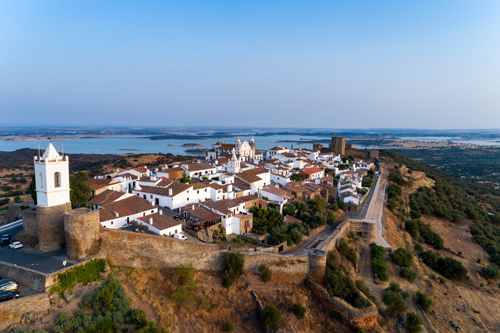Alentejo, a region in the wilds in South Portugal, is among Portugal’s hidden gems with rich history, beautiful coasts, huge rolling fields, and a relaxed pace.
About Alentejo
Alentejo is a region of the wilds in South Portugal. It is home to birds of prey flying over dense cork oak forests, Moorish forts standing on top of the hills, whitewashed medieval towns, and herds of goats grazing peacefully in the shade of cork trees – peeled, due to the great demand for their bark. Alentejo is an expansive region, mainly rural and sparsely populated, whose land comprises about one third of Portugal.
The name “Alentejo,” which means “beyond the Tagus River,” is derived from its location between the Tagus River and the Algarve. The Tagus is the largest river in the Iberian Peninsula, and it flows into the Atlantic Ocean near Lisbon. While the area doesn’t get much precipitation, many dams were built on the river and the rivers that feed it, turning agriculture into the area’s main economic source. Vineyards, olive groves, and cork oaks characterize the landscape and there are vast, carpet-like meadows between them that bloom with purple lavender and yellow chrysanthemums. A wide plain bordered on the east by a chain of high mountains and the wide Guadiana River form a natural border with Spain.
The province is divided into 2 corresponding provinces: Upper Alta Alentejo and Lower Baixo Alentejo. In the north, you’ll find the pastures of the marshlands; in the huge interior, fields of wheat, and, on the coast, beautiful beaches, coves, and rugged cliffs. The further south you go, the warmer the temperatures and the slower the pace of life.
You’ll find both leisure and entertainment in Alentejo. Water activities abound - dolphin watching, surfing, windsurfing, kite surfing, canoeing, kayaking, diving, sailing, and fishing. There are beautiful hikes and jeep rides, ballooning, open-air sports, and historical monuments and museums. Alentejo is home to wonderful cities like Evora, Estremoz, and Elvas which radiate a calm and slightly sleepy atmosphere that contradicts the central role they played in the history of Portugal – as evidenced by their designation as World Heritage sites. In Santarem, there is a natural viewpoint which overlooks the enormity of the Tagus, and around the hills you’ll find castles and gardens that evidence the Arab influences on the people and nature.
The pace of life in this region remained unchanged for hundreds of years and preserves the authenticity and mystery of centuries-old agricultural traditions, including the production of cork, which is Portugal's largest export industry. For good reason it is said that Alentejo is one of Portugal’s hidden gems!








